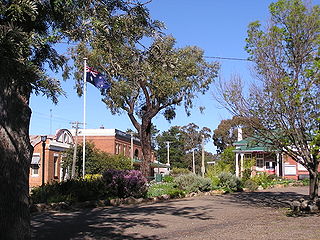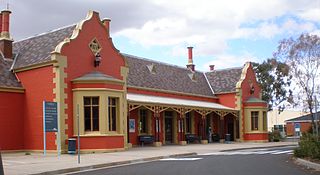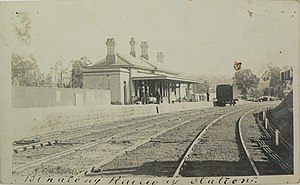
Boorowa is a farming village in the Hilltops Region in the south west slopes of New South Wales, Australia.

The Australian state of New South Wales has an extensive network of railways, which were integral to the growth and development of the state. The vast majority of railway lines were government built and operated, but there were also several private railways, some of which operate to this day.

The Sunshine rail disaster occurred on 20 April 1908 at the junction at Sunshine railway station when a Melbourne-bound train from Bendigo collided with the rear of a train from Ballarat. 44 people were killed and over 400 injured, almost all of them from the Ballarat train, as the Bendigo train was cushioned by its two locomotives.
The Gerogery level crossing accident was a vehicle-train crash that occurred at Bells Road on the Olympic Highway, where it crossed the Main Southern railway in Gerogery, New South Wales, Australia. The crash occurred on 27 January 2001 at 16:07 and resulted in five fatalities in a car that was struck by a Melbourne-bound XPT service travelling at 160 kmh. Although the train derailed in the impact, there were no deaths to the train passengers or crew. The crash site extended for more than 1 km south of the level crossing, with vehicle, train and rail track debris found throughout. There had been a continuing series of crashes at the level crossing prior to the fatal crash, resulting in the local road and rail authorities installing perceptual countermeasures such as warning signs and enhanced road markings in attempts to provide more information to drivers of the crossing location and characteristics and to influence vehicle approach speeds.

Burley Griffin Way is a New South Wales state route, is located in south eastern Australia. Named after the American architect Walter Burley Griffin, designer of the cities of Canberra and Griffith, the road links these two cities via Yass and Barton Highway.

Temora is a town in the north-east of the Riverina area of New South Wales, 418 kilometres (260 mi) south-west of the state capital, Sydney. At the 2021 census the population of Temora was 4,016.

Binalong is a village in the Southern Tablelands of New South Wales, Australia, 37 km north-west of Yass in Yass Valley Shire. At the 2016 census, Binalong and the surrounding area had a population of 543.

Goulburn railway station is a heritage-listed railway station on the Main Southern line in New South Wales, Australia. Opened on 19 May 1869, it serves the city of Goulburn. It was added to the New South Wales State Heritage Register on 2 April 1999.

Bowning is a small town in the South West Slopes, 14 kilometres (8.7 mi) west of Yass on the Hume Highway in Yass Valley Shire. Bowning is an aboriginal word meaning 'big hill'. At the 2016 census, Bowning and the surrounding area had a population of 573.

Bathurst railway station is a heritage-listed railway station located on Havannah Street, Bathurst, New South Wales, Australia. It is situated on the Main Western line and is the only railway station serving the city. The station was added to the New South Wales State Heritage Register on 2 April 1999.

The Main Southern Railway is a major railway in New South Wales, Australia. It runs from Sydney to Albury, near the Victorian border. The line passes through the Southern Highlands, Southern Tablelands, South West Slopes and Riverina regions.
The railways of New South Wales, Australia have had many incidents and accidents since their formation in 1831. There are close to 1000 names associated with rail-related deaths in NSW on the walls of the Australian Railway Monument in Werris Creek. Those killed were all employees of various NSW railways. The details below include deaths of employees and the general public.

The Coroner's Court of New South Wales is the court in the Australian state of New South Wales where legal proceedings, in the form of an inquest or inquiry, are held and presided over by the State Coroner of New South Wales, a Deputy State Coroner of New South Wales, or another coroner of the state of New South Wales.

Barmedman is a rural village in the Bland Shire in the New South Wales state of Australia, located approximately half-way between West Wyalong and Temora. Barmedman began as a service centre for gold-mining operations in the area. Nowadays the local district has an agricultural economic base, including wheat and canola cropping and sheep grazing. It is the home of two large wheat silos with a combined capacity of over a million bushels. At the 2011 census, Barmedman had a population of 212. The township's name is derived from an Aboriginal word meaning 'long water'.

The Temora railway station is a heritage-listed former railway station and now youth hub and mixed-use building located on the Lake Cargelligo railway line in Temora in the Temora Shire local government area of New South Wales, Australia. The station was built from 1893 to 1915 and served the Riverina town of Temora between 1 September 1893 until its closure for passenger services in the late 1970s. The station is also known as the Temora Railway Station group. The property was added to the New South Wales State Heritage Register on 2 April 1999.

The Burrowa News and Marengo, Binalong, Murrumburrah and Cootamundra Reporter was a weekly English language newspaper published in Boorowa, New South Wales, Australia.
The Maher Cup was an Australian rugby league challenge cup contested between towns of the South West Slopes and northern Riverina areas of New South Wales between 1920 and 1971. The main teams involved were Cootamundra, Tumut, Gundagai, Temora, West Wyalong, Young, Harden-Murrumburrah, Junee, Barmedman, Cowra, Grenfell and Boorowa.

Gunning railway station is a heritage-listed railway station located on the Main Southern line in the Upper Lachlan Shire of New South Wales, Australia. It serves the town of Gunning. It is also known as Gunning Railway Station and yard group. The property was added to the New South Wales State Heritage Register on 2 April 1999.
Illalong is a rural locality just off the Burley Griffin Way in south New South Wales.
The Salt Clay Creek railway disaster was one of Australia's first railway accidents involving multiple fatalities. It occurred on the evening of 25 January 1885, when a mail train from Albury to Sydney failed to negotiate a flooded creek, around 5 km from Cootamundra. Seven people were killed and dozens seriously injured.


















